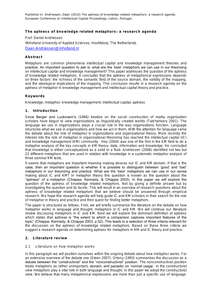Metaphors are common phenomena intellectual capital and knowledge management theories and practice. An important question to ask is: what are the ‗best‘ metaphors we can use in our theorizing on intellectual capital and knowledge management? This paper addresses the question of the aptness of knowledge related metaphors. It concludes that the aptness of metaphorical expressions depends on three factors: the richness of the semantic field of the source domain, the validity of the mapping, and the ideological implications of the mapping. This conclusion results in a research agenda on the aptness of metaphor in knowledge management and intellectual capital theory and practice.
DOCUMENT

In this paper we turn to the field of innovation management and the use of metaphors to address the question: what kind of alternative metaphors and narratives have some open-innovation organizations introduced highlighting and fostering knowledge-intensive organizational change? First we draw a comparative overview of characteristics of knowledge flows in general, that are specific for open innovation strategies, and that organizations want to highlight. Then we describe the use of metaphors by Philips, Pfizer, Chevron and RABO on their way towards open innovation strategies. Methodologically, the interpretation of the described metaphors will be based on a metaphor theory derived from the works of Joseph Campbell, Mircea Eliade, Carl Gustav Jung and Eugen Drewermann. Our analysis concludes by providing guidelines for necessary future research about the aptness of innovation metaphors for idea generation and knowledge creation.
DOCUMENT
In many fields within management and organizational literature there is considerable debate and controversy about key theoretical concepts and their definitions and meanings. Systematic metaphor analysis can be a useful approach to study the underlying conceptualizations that give rise to these controversies and putting them in perspective. It can help identify the different ways a theoretical concept is structured and given meaning, provide insight into the way these different conceptualizations relate to each other, and show how these conceptualizations impact further theorization about the concept. This article describes the procedure for a systematic analysis of the metaphors used to conceptualize key theoretical concepts. To examine its usefulness, the authors apply the approach to the field of social capital, and in particular to the concept of ‘relationships’ in organizations. In the metaphor analysis of three seminal articles on social capital, the authors identify seven metaphoric concepts for relationships. The metaphors are illuminated as important for providing imagery that adds specific meaning in the process of authors theorizing about social capital like ‘tie’, ‘path’ and ‘bridge’. They add dynamics and controllability to the concepts by attributing an array of verbs like ‘to move between’ or ‘to use’ relationships. In addition, the metaphors allow for the attribution of specific characteristics to the concept of relationships that can be used as variables in theory construction, such as the strength of a relationship or the ‘distance’ between people. These insights are useful in exploring and reconciling differences in social capital definitions.
DOCUMENT
